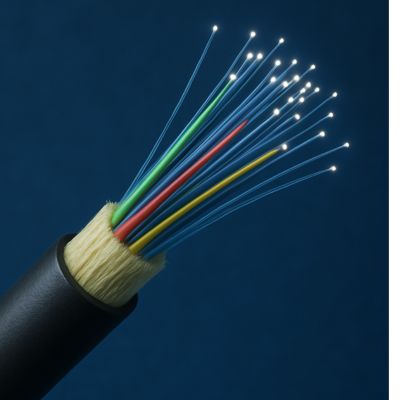For too long, residents in smaller towns and villages across the UK have been stuck with outdated broadband while cities get the best connections. Large providers like BT, Sky, and Talk Talk continue to sell part copper-based services in smaller communities, relying on infrastructure designed for telephone calls in the 1970s, not modern internet demands.
The Copper Conundrum: Why 70Mbps Isn’t Enough Anymore
Most large broadband providers in smaller communities still deliver internet services over copper telephone lines using Fibre-to-the-Cabinet (FTTC) technology. These networks typically max out at around 70 Mbps, and that’s only if you live close to the street cabinet. The further away you are, the slower your connection gets.
Consider what happens in your home right now. Multiple people streaming in HD, video calls for remote work, online gaming, smart home devices, cloud backups, and software updates all happening at once. A 70 Mbps copper connection struggles under this load. Issues arise like: Buffering during Netflix. Lag in video calls. Slow uploads when sharing files. Frustration when everyone’s online at the same time.
Copper broadband was never designed for how we use the internet today. It’s outdated technology trying to meet 2025 demands, and it shows.
The Fibre Advantage: Technology That Delivers
BeFibre takes a fundamentally different approach. They build Fibre-to-the-Premises (FTTP) networks, bringing fibre optic cables directly to your home. This isn’t a minor upgrade. It’s a complete transformation of what your broadband can do.
Speed That Makes a Difference
Copper tops out at around 70Mbps. BeFibre’s Full Fibre delivers speeds up to 2,300 Mbps. That’s over 30 times faster than BT, Sky, or TalkTalk’s copper networks.
Downloading a full HD movie? Ten minutes on copper. Under a minute on BeFibre Full Fibre.
Performance that stays consistent
Here’s where the technology really shows its superiority: Fibre optic cables transmit data using light signals, not electrical signals. That means virtually no signal degradation over distance. Whether you’re 100 metres or 10 kilometres from the exchange, you get the same fast speeds. Copper can’t match this consistency.
Upload Speeds That Match Download Speeds
Copper broadband is notorious for slow upload speeds. That 70 Mbps download often comes with just 15-20 Mbps upload. For video calls, cloud backups, and sharing large files, this is a problem.
BeFibre’s fibre offers symmetrical speeds, up to 2,300 Mbps. So your uploads are just as fast as your downloads. Video calls stay crystal clear even when others are streaming. Cloud backups happen in moments, not hours. Sharing large files becomes effortless.
Reliability You Can Trust
Copper cables are vulnerable to electromagnetic interference, weather conditions, and physical deterioration. Many copper networks in rural areas are decades old, leading to frequent faults and unreliable connections.
Fibre optic cables are immune to electromagnetic interference and far more resistant to environmental factors. They’re also more durable and require significantly less maintenance. Fewer outages. More stable connections. Less time spent on hold with customer service trying to fix problems.
Future-Proofing Your Connection
Copper broadband has reached its limit. There’s no upgrade path. What you get today is pretty much as good as it will ever be.
Full Fibre infrastructure is built for the future. The same fibre cables BeFibre are laying today can support speeds well beyond 2,300 Mbps by simply upgrading the equipment at either end. If you choose a company like BeFibre, you’re not just getting better broadband today. You’re ensuring your home won’t be left behind as digital demands continue to grow.
Lower Latency for Gaming and Video Calls
Latency, also known as ping time, is the delay between sending and receiving data. For gaming, video calls, and real-time applications, low latency matters.
Copper connections typically have latency of 20-30ms or higher, and this spikes during peak times. Full Fibre routinely achieves latency under 10ms, providing a noticeably more responsive experience.
For gamers, this is the difference between smooth gameplay and frustrating lag. For remote workers, it means video calls without awkward delays. For families, it means everyone can be online at once without anyone suffering.
BeFibre’s Community-First Mission
What sets BeFibre apart isn’t just the technology. It’s the commitment to market towns and villages that BT, Sky, and TalkTalk have overlooked.
The big providers focus on densely populated urban areas where the return on investment is highest. Smaller communities are left waiting indefinitely for upgrades that may never come.
BeFibre have chosen a different path. Recognising that people in market towns work, learn, create, and connect online just as much as city dwellers. Being digitally connected isn’t a luxury anymore. It’s essential for modern life, and smaller communities deserve the same quality of infrastructure as anywhere else.
Making the Switch Makes Sense
The choice between 70 Mbps copper from BT or Sky and BeFibre’s Full Fibre isn’t really a choice at all. The technical superiority is clear: speeds over 30 times faster, superior reliability, consistent performance regardless of distance, future-proof infrastructure, and lower latency.
But beyond the specifications, there’s a principle at stake. Should market towns accept second-rate infrastructure simply because they’re not major cities? We don’t think so, and neither should you.
Find out if BeFibre is in your area
Check your postcode on the BeFibre website.


